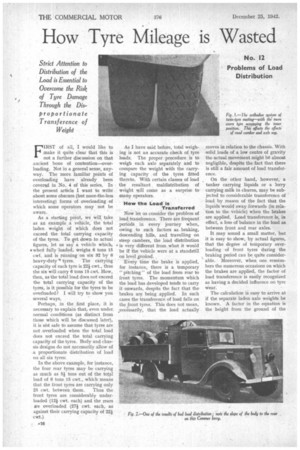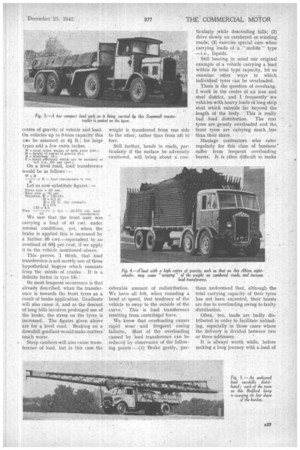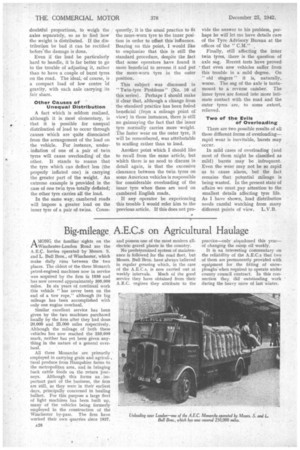How Tyre Mileage is Wasted
Page 28

Page 29

Page 30

If you've noticed an error in this article please click here to report it so we can fix it.
Strict Attention to Distribution of the Load is Essential to Overcome the Risk of Tyre Damage Through the DisProportionate Transference of
Weight
FIRST of all, I would like to .make it quite clear that this is not a further discussion on that ancient bone of contention—overloading. Not in a general sense, anyway. The more familiar points of overloading have already been covered in No. 4 of this series. In the present article I want to write about some obscure (but none-the-less interesting) forms of overloading of which some operators may . not be aware.
As a starting point, we will take as an example a vehicle, the total laden weight of which does not exceed the total carrying capacity of the tyres. To 4et down to actual figures, let us say a vehicle which, s whed fully loaded, weighs 6 tons 15 cwt. and is running on six 32 by 6 heavy-duty* tyres. The carrying capacity of each tyre is 22i cwt., thus the six will carry 6 tons 15 cwt. How, then, as the total load does not exceed the total carrying capacity of the tyres, is it possible for the tyres to be overloaded ? I will try to show you several ways.
Perhaps, in the first place, it is necessary to explain that, even under. normal conditions (as distinct from those which will be discussed later), it is nbt safe to assume that tyres are not overloaded when the total load does not exceed the total carrying capacity of the tyres. Body and chassis designs do not necessarily allow of a proportionate distribution of load on all six tyres.
In the above example, for instance, the four rear tyres may be carrying as much as Si tons out of the total load of 6 tons 15 cwt., which means that the front tyres are carrying only
25 cwt. between them. Thus the front tyres are considerably underloaded (14 cwt, each) and the rears are overloaded (27f cwt. each, as against their carrying capacity of 22f cwt.).
As I have said before, total weighing is not an accurate check of tyre loads. The proper procedure is to weigh each axle separately and to compare the weight with the carrying capacity of the tyres fitted thereto. With certain classes of load the resultant maldistribution of weight will come as a surprise to many operators.
How the Load' Is Transferred Now let us consider the problem of load transference. There are frequent perioda in every journey when, owing to snch factors as braking, descending hills, and travelling on steep cambers, the load distribution is very different from what it would be if the vehicle were at a standstill on level ground..
Every time the brake is applied, for instance, there is a temporary " pitching " of the load from rear to front tyres. The momentum which the load has developed tends to carry it onwards, despite the fact that the brakes arv being applied. In such cases the transference of load falls on the front tyres. This does not mean, ;necessarily, that the load actually moves in relation to the chassis. With solid loads of a low centre of gravity the actual movement might bt almost negligible, despite the fact that there is still a fair amount of load transference.
On the other hand, however, a tanker carrying liquids or a lorry carrying milk in churns, may be subjected to considerable transference of -load by reason of the fact that the liquids 'would sway forwards (in relation to the vehicle) when the brakes are applied. Load transference is, in effect, a loss of balance in the load as between front and rear axles.
It may sound a small matter, but it is easy to show, by actual figures, that the degree of temporary overloading of front tyres during the braking period can be quite considerable. Moreover, when one rem6mbers the numerous occasions on which the brakes are applied, the factor of load transference is easily recognized as having a decided influence on tyre 'Wear.
The calculation is easy to arrive at if the separate laden axle weights be known. A factor in the equation is the height from the ground of the centre of gravity of vehicle and load. On vehicles up to 3-tons capacity this , cam be assumed at 4* ft.; for large types add a few extra inches. •
W -total laden weight of both axles (cwt.). H.= height of centre of gravity (ft.).
B = wheelbase MA.
E brake efficiency which can be assumed as -0.5 (i.e. 50 per cent.).
On a level road, load transference would be as follows :—
wicH x E load transference In cwt.
Let us now substitute figures :—
Front axle iv 45 cwt.
Rear axle w 90 cwt.
Therefore, 1Y = 135 cwt.
B = 10 ft. for example), E 0.5, 155 x 4.5 Then x 0.5 = 30.375 cat. load
We saw that the front axle was carrying a load of 45 cwt. under normal conditions, yet, when the brake is applied this is increased by a further 30 •cwt.—equivalent to an overload of 661 per cent. if we apply it to the vehicle mentioned above.
This proves, I think, that load transference is not merely one of those hypothetical bogeys which emanate from the minds of cranks. It is a definite factor in tyre life.'
Its most frequent occurrence is that already described, when the transference is towards the front tyres as a result of brake application. Gradients will also cause it, and as the descent. of long hills involves prolonged use of the brake, the stress on the tyres. is increased. The figures given above are for a level road: Braking on a downhill gradient would make matters much worse.
Steep cambers-will also cause transference of load, but in this case the
weight is transferred from one side to the other, rather than from aft to fore.
Still further, bends in roads, particularly if the surface be adversely cambered, will bring abont a con siderable amount of redistribution. We have all felt, when rounding a bend at speed, that tendency of the vehicle to sway to the outside of the curve: This is load transference resulting from centrifugal force.
We know that overloading causes rapid wear and frequent casing failures., Most of the overloading caused by load transference can be reduced by observance of the following points :—(ly Brake gently, par
ticularly ,while descending hills; (2) drive slowly on cambered or. winding roads; (3) exercise special care when carrying loads of a " mobile " type —i.e., liquids.
Still bearing in mind our original example of a vehicle carrying a load within its total type capacity, let us examine other ways in which individual tyres can be overloaded.
There is the question of overhang. I work in the centre of an iron and steel district, and I frequently' see vehicles with heavy loads of long strip steel which extends far beyond the length of the body. This is really bad load distribution. The rear tyres are grossly overloaded and the, front tyres are carrying much less than their share.
Haulage contractors who cater regularly for this class of business' suffer from frequent overloading bursts. It is often difficult to make them understand that, although the total carrying , capacity of their tyres has not been exceeded, their bursts are due to overloading owing to faulty distribution.
Often, too, loads are badly distributed in order to facilitate unloading, especially in those cases where the delivery is divided between two or three addresses.
It is always worth while, before making a long journey with a load of doubtful proportions, to weigh the axles separately, so as to find how the weight is distributed. If the distribution be bad it can be rectified beforethe damage is done.
Even if the load be particularly hard to handle, it is far better to go to the trouble of adjusting it, rather than to have a couple of burst tyres on the road. The ideal, of course, is a compact load of low centre bf gravity, with each axle carrying its fair share.
Other Causes of Unequal Distribution
A fact which is seldom realized, although it is most elementary, is that it is possible for unequal distribution of load to occur through causes which are quite dissociated from the arrangement of the load on the vehicle. For instance, underinflation of one of a pair of twin tyres will cause overloading of the other. It stands to reason that the tyre which can deflect less (the properly inflated one) is carrying the greater part of the weight. An extreme example is provided in the case of one twin tyre totally deflated; the other tyre carries all the load.
In the same way, cambered roads will impose a greater load on the inner tyre of a pair of twins. Conse quently, it is the usual practice to fit the more-worn tyre to the inner position in order to offset this-influence. Beating on this point, I would like to emphasize that this is still the standard procedure, despite the fact that some operators have found it more beneficial to reverse it and put the more-worn tyre in the outer position.
This subject was discussed in "Twin-tyre Problems" (No. 10 of this series). Perhaps I should make it clear that, although a change from the standard practice has been fonnd beneficial (from a mileage point of view) in these instances, there is still no gainsaying the fact that the inner tyre normally carries more weight. The faster wear on the outer tyre, it will be remembered, was attributable to scuffing rather than to load.
Another point which I should like to recall from the same article, but which there is no need to discuss in detail again, is that the excessive clearance between the twin tyres on some American vehicles is responsible for considerable overloading of the inner tyre when these are used on cambered English roads.
If any operator be experiencing this trouble I would refer him to the previous article. If this does not pro. vide the answer to his problem, perhaps he will let me have details care of the Tyre Advisory Bureau at the offices of the " C.M."
Finally, still affecting the inner twin tyres, there is the question of axle sag. Recent tests have proved ' that even new vehicles suffer from this trouble in a mild degree. On " old stagers" it is, naturally, worse. The sag of the axle is tantamount to a reverse camber. The inner tyres are forced into more intimate contact with the road and the outer tyres are, to some extent, relieved.
Two of' the Evils of Overloading There are two possible results of all these different forms of overloading— rapid wear is inevitable, bursts may
In mild cases of overloading (and most of them might be classified as mild) bursts may be infrequent. Even the wear may not be so rapid as to cause alarm, but the fact remains that potential mileage is being wasted. In the present state of affairs we must pay attention to the smallest details affecting tyre life. As I have shown, load distribution needs careful watching from many different points of view. L.V.B.




















































